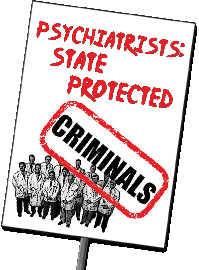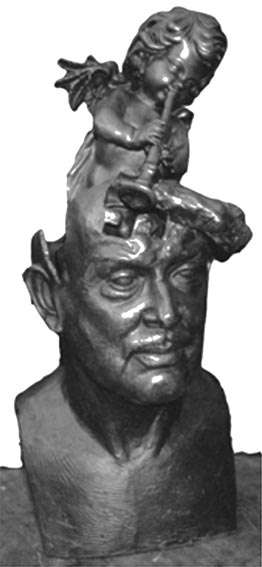Psychiatry: Fake science. Real harm.
German psychiatry: murdering back then, still torturing now


The Missing Link
Assemblage of Karl Bonhoeffers bust
by Igael Tumarkin
"Castration thoughts come with angels music",
rendering a swastika on his head
by Igael Tumarkin
"Castration thoughts come with angels music",
rendering a swastika on his head
The mass murder program in the institutions had been long planned by physicians. In order to get it going, an eradication program served as an intermediate step with a delaying effect: forced sterilization.
For this doctors received the political support and protection of the Nazis when they came into power in 1933. Karl Bonhoeffer, the President of the German Association for Psychiatry, which was the precursor of the DGPPN, wrote the corresponding guideline book in 1934 in order to determine the "range of those to exterminate" (Bereich der Auszumerzenden)*, a citation by Karl Bonhoeffer.
Karl Bonhoeffer thus became the intellectual arsonist of the doctor-Nazi extermination program. Psychiatry, which he chaired, built the "missing link", the bridge piece that connects the land of mass murderers and executioners with the land of poets and thinkers.
For this doctors received the political support and protection of the Nazis when they came into power in 1933. Karl Bonhoeffer, the President of the German Association for Psychiatry, which was the precursor of the DGPPN, wrote the corresponding guideline book in 1934 in order to determine the "range of those to exterminate" (Bereich der Auszumerzenden)*, a citation by Karl Bonhoeffer.
Karl Bonhoeffer thus became the intellectual arsonist of the doctor-Nazi extermination program. Psychiatry, which he chaired, built the "missing link", the bridge piece that connects the land of mass murderers and executioners with the land of poets and thinkers.
* The psychiatric tasks during the execution of the law for the prevention of hereditarily diseased offspring, with an appendix: "Die Technik der Unfruchtbarmachung" (The technology of causing infertility), March, 1934: http://www.dissidentart.de/kb_buch
or order print versions for further distribution here:
- The Racism of Psychiatry and
the Deadly Connection between German and International Psychiatry by Thomas Foth - The Missing Link
- The Proof
- Psychiatrists recommend to you wonderful Berlin...
- Quote by Prof. Thomas Szasz
- Coercive psychiatry a torture system by Alice C. Halmi
- Why "mental illness" does not exist
- Coercive psychiatry can be put to a stop
- Quotes by Gert Postel, "The imposter among imposters".
- Easily make a protest poster
"It wasn‘t the Nazis who needed the doctors, rather the doctors who needed the Nazis."
Ernst Klee
Ernst Klee
The Proof
Review:
Hunger deaths in Psychiatry 1914-1949
Original title (in German only):
Hungersterben in der Psychiatrie 1914-1949
by Heinz Faulstich published by Lambertus
Among the almost unknown crimes of the 20th century by psychiatry is the mass murder by starvation in the psychiatric institutions. Heinz Faulstich, a retired psychiatrist who previously was deputy director of the provincial hospital on the island of Reichenau for 17 years, delivered the evidence that the systematic mass murder of part of its own population, which had to be eradicated according to alleged medical/biological characteristics, was a crime that was conceived and executed by physicians, above all psychiatrists.
To distract from the true perpetrators, it was, and still is, attempted to propagate the myth that doctors were only „mis- used“ by the Nazis for this crime. A few doctors with a weak conscience were deemed to having become Nazi doctors, thus the deeds were not attributable to genuine doctors, but rather to the Nazis. The word is spread that these Nazis had a "delusion" ("racial delusion in the Third Reich"), so they were "mad", an irrational, so to speak "non-terrestrial" form of life that had made the good doctors into their tool. With this myth, the guilt of the perpetrator was to be repudiated and by that maliciously equated the supposedly "insane" perpetrators with their victims*. However, if the offenders had been Nazis, logically the mass murders should have ended with the surrender of the Nazis on 8/9 May 1945. In fact the murders in the psychiatries continued uninterrupted until 1948/9.
That having been proved is the merit of Heinz Faulstich. He researched in detail for many years on this topic, where professional historians had failed. The killing by starvation needed only a few guidelines by the doctors but many who went along with it. It was murder, because anybody who locks up another person, as is the norm in psychiatry, assumes the responsibility for his/her nutrition and must ensure an adequate food supply. By omission, death is caused with full intention and with this goal in mind. It is partly murder for it’s own sake, as were the gas chamber killings, and partly murder out of greed, because food rations intended for the incarcerated were self-servingly consumed, sold or black-marketed by the staff. In the early post-war years at least 25,000 German prisoners of psychiatry starved to death. In the Soviet zone alone the mortality rate in the psychiatries was 1946: 23.2%, 1947: 18.8% and 1948: 11.4%. In 1933 approximately three out of one hundred patients died annually.
As people died in a psychiatric institution also for other reasons, Faulstich had to go through the death registers of almost all German psychiatric institutions to examine the nutrition for individual regions and localities in a differentiated manner to find out how many people were forced to starve to death.
This, together with the landmark book by Henry Friedlander: The Origins of Nazi Genocide: From Euthanasia to the Final Solution proved what the historian Götz Aly has summarized thus: "These killings paved the way for the Holocaust" **.
* See press release by Klaus Wowereit 2014: http://tinyurl.com/hbwfw5n
** Source: Aachener Zeitung October 2015: http://tinyurl.com/zkkz8a9
Hunger deaths in Psychiatry 1914-1949
Original title (in German only):
Hungersterben in der Psychiatrie 1914-1949
by Heinz Faulstich published by Lambertus
Among the almost unknown crimes of the 20th century by psychiatry is the mass murder by starvation in the psychiatric institutions. Heinz Faulstich, a retired psychiatrist who previously was deputy director of the provincial hospital on the island of Reichenau for 17 years, delivered the evidence that the systematic mass murder of part of its own population, which had to be eradicated according to alleged medical/biological characteristics, was a crime that was conceived and executed by physicians, above all psychiatrists.
To distract from the true perpetrators, it was, and still is, attempted to propagate the myth that doctors were only „mis- used“ by the Nazis for this crime. A few doctors with a weak conscience were deemed to having become Nazi doctors, thus the deeds were not attributable to genuine doctors, but rather to the Nazis. The word is spread that these Nazis had a "delusion" ("racial delusion in the Third Reich"), so they were "mad", an irrational, so to speak "non-terrestrial" form of life that had made the good doctors into their tool. With this myth, the guilt of the perpetrator was to be repudiated and by that maliciously equated the supposedly "insane" perpetrators with their victims*. However, if the offenders had been Nazis, logically the mass murders should have ended with the surrender of the Nazis on 8/9 May 1945. In fact the murders in the psychiatries continued uninterrupted until 1948/9.
That having been proved is the merit of Heinz Faulstich. He researched in detail for many years on this topic, where professional historians had failed. The killing by starvation needed only a few guidelines by the doctors but many who went along with it. It was murder, because anybody who locks up another person, as is the norm in psychiatry, assumes the responsibility for his/her nutrition and must ensure an adequate food supply. By omission, death is caused with full intention and with this goal in mind. It is partly murder for it’s own sake, as were the gas chamber killings, and partly murder out of greed, because food rations intended for the incarcerated were self-servingly consumed, sold or black-marketed by the staff. In the early post-war years at least 25,000 German prisoners of psychiatry starved to death. In the Soviet zone alone the mortality rate in the psychiatries was 1946: 23.2%, 1947: 18.8% and 1948: 11.4%. In 1933 approximately three out of one hundred patients died annually.
As people died in a psychiatric institution also for other reasons, Faulstich had to go through the death registers of almost all German psychiatric institutions to examine the nutrition for individual regions and localities in a differentiated manner to find out how many people were forced to starve to death.
This, together with the landmark book by Henry Friedlander: The Origins of Nazi Genocide: From Euthanasia to the Final Solution proved what the historian Götz Aly has summarized thus: "These killings paved the way for the Holocaust" **.
* See press release by Klaus Wowereit 2014: http://tinyurl.com/hbwfw5n
** Source: Aachener Zeitung October 2015: http://tinyurl.com/zkkz8a9